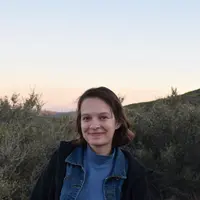2020 Carnegie Summer Student Profiles

Name: Micaela Berglund
School: Pomona College
Advisor: Allison Strom
Micaela Berglund of Pomona College studied 21 low-metallicity star-forming galaxies that share spectral fingerprints with the extreme environments of high-redshift galaxies. Her work will be widely applicable for improving models of galaxies at all redshifts. She selected Carnegie’s internship program for the opportunity to undertake formal research before applying to Ph.D. programs, a process for which she is grateful to have the support and encouragement of Carnegie mentors. “This summer gave me a unique glimpse into the dynamics of a community of astrophysicists; I was impressed by how inclusive and forward-thinking the community at Carnegie is.”

Name: Joseph Cachaldora
School: Caltech
Advisor: Ting Li
Joseph Cachaldora of Caltech spent the summer developing a web-based spectral visualization tool for the Southern Stellar Stream Spectroscopic Survey, a collaboration that aims to map the motion and chemistry of stellar streams in the Southern Hemisphere. The tool will provide the initiative with a simplistic and organized spectral analysis experience. He’d heard about the Carnegie internship program from a previous participant and said it “lived up to every expectation” despite the switch to a virtual format. “This experience has taught me how to approach a large goal or project by dividing it into small segments,” he said. “Now, rather than getting confused or intimidated by a complicated overall idea for a project, I can feel more confident in my ability to manage and organize it into portions and to eventually create a finished product.”

Name: Linnea Dahmen
School: Pomona College
Advisor: Decker French
Returning summer intern Linnea Dahmen of Pomona College spent the summer trying to better understand why post-starburst galaxies stop forming stars so abruptly. One possible answer is the effect of gas accretion around the galaxy's central supermassive black hole. She was able to use a long tail of ionized gas extending from one particular post-starburst galaxy as an echo of the energy output of its black hole. "It’s special how much scientific autonomy you get as an intern,” she said. "Unlike other programs, at Carnegie, you really get to take ownership of your research project.” Dahmen's 2020 summer experience taught her the value of reaching out for advice. "There are so many people at Carnegie willing to talk with you through your questions, whether it’s about science or about your life path." She's now working on a paper summarizing all the work she's done the past two summers.
Name:

School: Cal Poly Pomona
Advisor: Jeff Rich
Cal Poly Pomona student Jeysen Flores was particularly interested in learning Python this summer. His research focused on NGC3256, a luminous infrared galaxy located 100 million light-years away from Earth. It is an ideal target to investigate how shocked gas may play a role in how the star formation begins, operates, and ends in these types of galaxies. “I learned that communication is the most important aspect of any working environment due to the fact that one can establish connections with many scientists who work in all sorts of fields,” Flores said, adding that the virtual setting allowed him to develop communication skills, because it required more personal interactions.

Name: Beryl Hovis-Afflerbach
School: Caltech
Advisor: Ylva Götberg
Caltech student Beryl Hovis-Afferbach researched stripped stars in low metallicity environments, which are created when a massive star in a binary system swells and is stripped of its outer material by its companion. Although expected to be common, almost none have been observed. “This was my first time doing research in stellar evolution and binary stars, as well as my first project with a more theoretical and computational basis,” she said. She said the program improved her written and oral communication abilities and increased her confidence about sharing her work. “Presenting at group meetings and writing interim reports have given me many opportunities to practice these skills,” she said.

Name: Cynthia Ibrahim
School: San Diego State University
Advisor: Greg Walth
San Diego State University student Cynthia Ibrahim investigated the spectral properties of galaxies within quasar environments, focusing on specific emission lines. She selected Carnegie's summer internship program because of the Observatories' reputation for interesting research. "This summer experience has shown me the importance of having a support group and connections within the astronomy community," she said. "Day by day I learned how to become a better researcher and science communicator, and how to advocate for my interests." As a result of her experiences in the internship, she has broadened her possible graduate school research interests. "Although being at home and having a full-time internship to work on has been challenging in terms of balancing responsibilities, I always knew that I could reach out to my mentors and cohort for support or questions," she concluded.
Name:

School: UCLA
Advisor: Andrew Emerick
UCLA student Suyash Kumar investigated metal mixing in simulated dwarf galaxies with a particular focus on the evolution of metal abundance distributions in the neutral phase of the Interstellar Medium and their relationship with physical properties of the galaxy, such as the star-formation rate, dark matter halo-mass, and gas turbulence. Looking forward, he wants to extend this work to heavier dwarf galaxies and Milky Way sized galaxies. He was attracted to the program because of the Observatories cultural reputation and role in the history of astronomy. “I think the biggest takeaway from my time at Carnegie was that it is perfectly alright to not know everything and therefore keep working towards knowing more!” he exclaimed. “Research has been a completely different ballgame in comparison to academics, and I have really cherished my time doing the former, having rediscovered my love for the cosmos.”

Name: Alexandra Kwon
School: UCLA
Advisor: Lauren Anderson
Alexandra Kwon of UCLA spent the summer modeling the evolution of chemical abundances in dwarf galaxies. She used the observed metallicities of the stars in a dwarf galaxy today, along with the galaxy’s measured star formation rate, to generate a model that quantifies the metallicity of the galaxy at different time periods. Her biggest takeaway from the experience was the discovery that even experts are always learning new things about their research subjects. “Even my mentor was learning new things as we went through the project. This helped me to realize that the whole point of conducting research is to learn more,” she said. Kwon particularly praised the mentorship aspect of the internship program. “This helped us to meet, learn from, and create relationships with more people involved with Carnegie. One of the benefits of this being a virtual internship is that I was able to meet with mentors around the world that I might not have been able to meet if we were in person.”

Name: Allen Marquez
School: Cal State L.A.
Advisor: Alex Ji
Allen Marquez of Cal State L.A. spent the summer focused on the origin of stars—where they were born and the processes that created their elemental compositions. “As the collection of this data is growing, newer methods need to be developed to analyze all this data,” he explained, which is why he worked on automating the process of analyzing and deriving the properties of stars. He praised the program for sharpening this communication skills, teaching him how to share his work with both peers and professionals. “It has also shown me how vast the field of astronomy is,” said, adding that “this has easily been the best experience of my academic career.” He hopes to be able to return next summer.

Name: Gavin McCabe
School: Caltech
Advisor: Shuvo Uddin
Caltech student Gavin McCabe applied machine learning techniques to classifying images of supernova host galaxies as elliptical or spiral, removing the time-consuming and error-prone human element from this work. He said the Carnegie summer internship program provided him with "a great opportunity to get involved in astronomy and learn what the field is about. I’ve never done astronomy before, but loved physics and computer science, so Carnegie allowed me to apply what I’ve learned in class to a real-world project that can help scientists in the future." McCabe added that the experience taught him "how to ask for help, and how failing is not only okay, it’s encouraged." About the pandemic-necessitated switch to a virtual internship program, he concluded: "Although virtual internships can be difficult, I feel that this program has done the best job possible in making this a worthwhile experience."

Name: Pei Qin
School: Pomona College
Advisor: Josh Simon
Last summer, returning intern Pei Qin of Pomona College pursued an instrumentation project, but this year she wanted to try tackling data analysis. She searched the second tranche of data released by the European Space Agency’s Gaia mission in 2018 for for tidal tails of globular clusters. Her goal was to develop a data analysis pipeline using both photometric and astrometric filters to more easily determine which stars belong to the clusters and hence identify tidal deformations around them. “Having a community and a good support systems is so important in research,” she said, noting that the addition of a virtual mentorship team for each student this year provided access for different sources of information about science, programming, outreach, and graduate school applications, as well as for overall encouragement. “I think this summer for me served as a great lesson that science is a human endeavor and it is deeply collaborative,” she concluded.